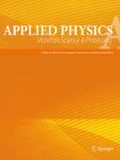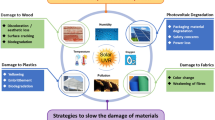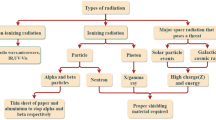Abstract
The direct effects of tungsten trioxide (WO3) on gamma radiation attenuation properties of tungsten/barium/phosphate glasses with chemical form xWO3–(50-x/2)BaO–(50-x/2)P2O3, x = 0 (S1)–60 (S7) in steps of 10 mol% has been investigated. To this end, Phy-X/PSD software and Monte Carlo code were applied. The increased amount of WO3 in the glass composition, on the other hand, contributed positively to the increase in density and radiation sensing properties. At the lowest and highest WO3 contributions, a nearly twofold increase in HVL value was seen for the S1 and S7 glass samples, respectively, with S7 having the lowest HVL values. The HVL has obeyed the trend as: (HVL)S1 > (HVL)S2 > (HVL)S3 > (HVL)S4 > (HVL)S5 > (HVL)S6 > (HVL)S7. The variation of the tenth value layer (TVL) for all studied glasses has the same trend of HVL. In terms of mean free path (MFP), there was negative effect of WO3 concentration on the trend of MFP. Consequently, S7 glass sample has the lowest values of MFP, while the S1 glass sample has the highest values. Therefore, (MFP)S1 > (MFP)S2 > (MFP)S3 > (MFP)S4 > (MFP)S5 > (MFP)S6 > (MFP)S7. A comparison of the HVL of S7 glass sample with some commercial radiation shielding materials such as different types of concrete and RS-253-G18 glasses has been performed and concluded that the S7 glass sample is superior as radiation shielding material than several commercial materials. It can be concluded that WO3 reinforcement serves a multipurpose of increasing the density and hence the gamma-ray-shielding characteristics of comparable glass compositions.












Similar content being viewed by others
Data availability
The data presented in this study are available on request from the corresponding author.
References
N. Singh, K.J. Singh, K. Singh, H. Singh, Comparative study of lead borate and bismuth lead borate glass systems as gamma-radiation shielding materials. Nucl. Instrum. Methods Phys. Res. Sect. B Beam Interact. Mater. Atoms 225, 305–309 (2004)
E. Kavaz, F.I. El Agawany, H.O. Tekin, U. Perişanoğlu, Y.S. Rammah, Nuclear radiation shielding using barium borosilicate glass ceramics. J. Phys. Chem. Solids 142, 109437 (2020)
A. Chahine, M. Et-tabirou, J.L. Pascal, FTIR and Raman spectra of the Na2O–CuO–Bi2O3–P2O5 glasses. Mater. Lett. 58, 2776–2780 (2004)
A. El-Taher, A.M. Ali, Y.B. Saddeek, R. Elsaman, H. Algarni, Kh.S. Shaaban, T. Amer, Gamma ray shielding and structural properties of iron alkali alumino-phosphate glasses modified by PbO. Radiat. Phys. Chem. 165, 108403 (2019)
S.A.M. Issa, M.I. Sayyed, A.M.A. Mostafa, G. Lakshminarayana, I.V. Kityk, Investigation of mechanical and radiation shielding features of heavy metal oxide based phosphate glasses for gamma radiation attenuation applications. J. Mater. Sci. Mater. Electron. 30, 12140–12151 (2019)
E.-S. Waly, G.S. Al-Qous, M.A. Bourham, Shielding properties of glasses with different heavy elements additives for radiation shielding in the energy range 15–300 keV. Radiat. Phys. Chem. 150, 120–124 (2018)
R.G. Jaeger, Engineering compendiumon radiation shielding, volume II: shielding materials (Springer-Verlag, International Atomic Energy Agency, Vienna, 1975)
N. Singh, K.J. Singh, K. Singh, H. Singh, Gamma-ray attenuation studies of PbO–BaO–B2O3 glass system. Radiat. Meas. 41, 84–88 (2006)
M. Saad, H. Elhouichet, Good optical performances of Eu3+/Dy3+/Ag nanoparticles co-doped phosphate glasses induced by plasmonic effects. J. Alloys Compd. 806, 1403–1409 (2019)
G. Moulika, S. Sailaja, B.N.K. Reddy, V.S. Reddy, S. Dhoble, B.S. Reddy, Optical properties of Eu3+ and Tb3+ ions doped alkali oxide (Li2O/Na2O/K2O) modified boro phosphate glasses for red, green lasers and display device applications. Physica B 535, 2–7 (2018)
M.K. Hwang, I.G. Kim, B.K. Ryu, Study of water resistance of Fe 2 O 3 doped P 2 O 5–ZnO–Bi 2 O 3 sealing glass system, Korean. J Met. Mater. 54, 621–625 (2016)
J. Šantić, L. Nikolić, R.D. Pavić, P. Banhatti, L. Mošner, A. Koudelka, Moguš- Milanković, scaling features of conductivity spectra reveal complexities in ionic, polaronic and mixed ionic-polaronic conduction in phosphate glasses. Acta Mater. 175, 46–54 (2019)
Y.B. Peng, D.E. Day, High thermal expansion phosphate glasses part 2. Glass Technol. 32, 166 (1991)
D.S. Brauer, C. Rüssel, J. Kraft, Solubility of glasses in the system P2O5–CaO–MgO–Na2O–TiO2: experimental and modeling using artificial neural networks. J. Non-Cryst. Solids 353, 263 (2007)
V.P. Singh, N.M. Badiger, N. Chanthima, J. Kaewkhao, Evaluation of gamma-ray exposure buildup factors and neutron shielding for bismuth borosilicate glasses. Radiat. Phys. Chem. 98, 14–21 (2014)
L. Koudelka, J. Šubčík, P. Mošner, I. Gregora, L. Montagne, L. Delevoye, I. Gregora, Glass-forming ability and structure of glasses in ZnO-WO3-P2O5 system. Phys Chem Glasses Eur J Glass Sci Technol B 53, 79–85 (2012)
L. Koudelka, I. Rösslerová, P. Mošner, Z. Černošek, M. Lissová, M. Liška, L. Montagne, L. Delevoye, Structure and properties of lead tungstate-phosphate glasses. Phys. Chem. Glasses Eur. J. Glass Sci. Technol. B 53, 86–92 (2012)
G. Pal Singh, D.P. Singh, Effect of WO3 on structural and optical properties of CeO2–PbO–B2O3 glasses. Phys. B Condens. Matter 406, 640–644 (2011)
Y. Saito, S. Uchida, T. Kubo, H. Segawa, Energy-storable dye-sensitized solar cells with tungsten oxide charge-storage electrode. J. Electrochem. Soc. 16, 27 (2009)
F.G.K. Baucke, K. Bange, T. Gambke, Reflecting electrochromic devices. Displays 9, 179 (1988)
C.G. Granqvist, A. Azens, J. Isidorsson, M. Kharrazi, L. Kullman, T. Lindström, G.A. Niklasson, C.-G. Ribbing, D. Rönnow, M. Strømme Mattsson, M. Veszelei, Towards the smart window: progress in electrochromics. J. Non-Cryst. Solids 218, 273 (1997)
S.A.M. Issa, M. Rashad, A. Hanafy Taha, B. Saddeek Yasser, Experimental investigations on elastic and radiation shielding parameters of WO3-B2O3-TeO2 glasses. J. Non-Cryst. Solids 544, 120207 (2020)
R. El-Mallawany, L. El-Deen, M. Elkholy, Dielectric properties and polarizability of molybdenum tellurite glasses. J. Mater. Sci. 31, 633943 (1996)
H. Qiu, M. Kudo, H. Sakata, Synthesis and electrical properties of Fe2O3-MoO3-TeO2 glasses. Mater. Chem. Phys. 51, 233e8 (1997)
J. Pisarska, R. Lisiecki, W. Ryba-Romanowski, G. Domniak-Dzik, W.A. Pisarski, Up-converted luminescence in YbeTm codoped lead fluoroborate glasses. J. Alloys Compd. 451, 226e8 (2008)
G.P. Singh, P. Kaur, S. Kaur, D.P. Singh, Role of WO3 in structural and optical properties of WO3eAl2O3ePbOeB2O3 glasses. Physica B406, 4652e6 (2011)
B.H. Jung, D.K. Kim, H.-S. Kim, Properties and structure of (50–x) BaO-xZnO-50P2O5. J. Non-Cryst. Solids 351, 3356–3360 (2005)
A. Saeed, R.M. Elshazly, Y.H. Elbasher, A.M. Abou El-azm, M.M. El-Okr, M.N.H. Comsan, A.M. Osman, A.M. Abdal-monem, A.R. El-Sersy, Gamma ray attenuation in a developed borate glassy system. Radiat. Phys. Chem. 102, 167–170 (2014)
RSICC Computer Code Collection (2002) MCNPX user’s manual version 2.4.0. Monte Carlo N-particle transport code system for multiple and high energy applications
E. Şakar, Ö.F. Özpolat, B. Alım, M.I. Sayyed, M. Kurudirek, Phy-X/PSD: development of a user friendly online software for calculation of parameters relevant to radiation shielding and dosimetry. Radiat. Phys. Chem. 166, 108496 (2020). https://doi.org/10.1016/j.radphyschem.2019.108496
P. Kalenda, L. Koudelka, P. Mošner, L. Montagne, B. Revel, Glass-forming ability and the structure of glasses in the BaO-WO3-P2O5 system. J. Non-Cryst. Solids 541, 120145 (2020)
M.I. Sayyed, B.O. Ashok Kumar, K.A. El-bashir, M.H.M. Mahmoud, H.A.A. Sidek. Zaid, K.A. Matori, Investigation of the mechanical and radiation shielding features for BaO-WO3-P2O5 glass systems. Optik 258, 168810 (2022). https://doi.org/10.1016/j.ijleo.2022.168810
M. Almateri, O. Agar, E.E. Altunsoy, O. Kilicoglu, M.I. Sayyed, H.O. Tekin, Photon and neutron shielding characteristics of samarium doped lead alumino borate glasses containing barium, lithium and zinc oxides determined at medical diagnostic energies. Res. Phys. 12, 2123–2128 (2019). https://doi.org/10.1016/j.rinp.2019.01.094
H.O. Tekin, G. ALMisned, Y.S. Rammah, G. Susoy, F.T. Ali, D.S. Baykal, H.M.H. Zakaly, S.A.M. Issa, A. Ene, Mechanical properties, elastic moduli, transmission factors, and gamma-ray-shielding performances of Bi2O3–P2O5–B2O3–V2O5 quaternary glass system. Open Chem. 20, 314–329 (2022). https://doi.org/10.1515/chem-2022-0145
H.O. Tekin, G. Almisned, G. Susoy, F.T. Ali, D.S. Baykal, A. Ene, S.A.M. Issa, Y.S. Rammah, H.M.H. Zakaly, Transmission factor (TF) behavior of Bi2O3–TeO2–Na2O–TiO2–ZnO glass system: a Monte Carlo simulation study. Sustainability 14, 2893 (2022). https://doi.org/10.3390/su14052893
I.I. Bashter, Calculation of radiation attenuation coefficients for shielding concretes. Ann. Nucl. Energy 24, 1389–1401 (1997)
Acknowledgements
This work was performed under Princess Nourah Bint Abdulrahman University Researchers Supporting Project Number (PNURSP2022R149), Princess Nourah Bint Abdulrahman University, Riyadh, Saudi Arabia. The authors express their sincere gratitude to Princess Nourah Bint Abdulrahman University.
Funding
Princess Nourah Bint Abdulrahman University Researchers Supporting Project Number (PNURSP2022R149).
Author information
Authors and Affiliations
Corresponding authors
Ethics declarations
Conflict of interest
The authors declare no conflict of interest.
Institutional review board
Not applicable.
Informed consent
Not applicable.
Additional information
Publisher's Note
Springer Nature remains neutral with regard to jurisdictional claims in published maps and institutional affiliations.
Rights and permissions
About this article
Cite this article
Tekin, H.O., ALMisned, G., Rammah, Y.S. et al. The significant role of WO3 on high-dense BaO–P2O3 glasses: transmission factors and a comparative investigation using commercial and other types of shields. Appl. Phys. A 128, 470 (2022). https://doi.org/10.1007/s00339-022-05620-y
Received:
Accepted:
Published:
DOI: https://doi.org/10.1007/s00339-022-05620-y




